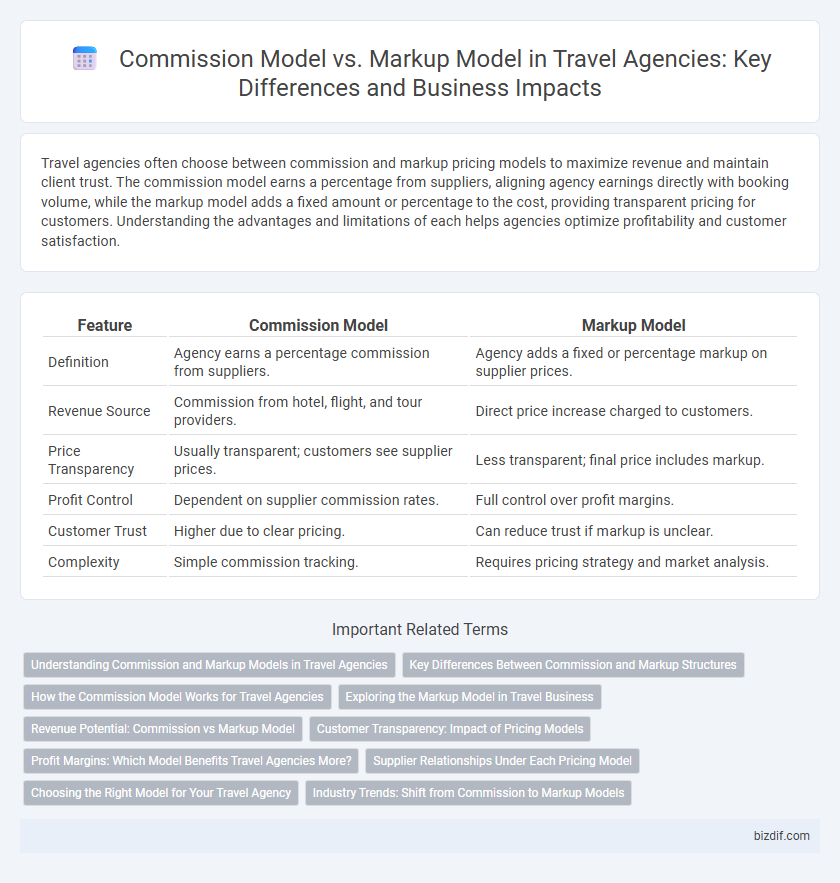Travel agencies often choose between commission and markup pricing models to maximize revenue and maintain client trust. The commission model earns a percentage from suppliers, aligning agency earnings directly with booking volume, while the markup model adds a fixed amount or percentage to the cost, providing transparent pricing for customers. Understanding the advantages and limitations of each helps agencies optimize profitability and customer satisfaction.
Table of Comparison
| Feature | Commission Model | Markup Model |
|---|---|---|
| Definition | Agency earns a percentage commission from suppliers. | Agency adds a fixed or percentage markup on supplier prices. |
| Revenue Source | Commission from hotel, flight, and tour providers. | Direct price increase charged to customers. |
| Price Transparency | Usually transparent; customers see supplier prices. | Less transparent; final price includes markup. |
| Profit Control | Dependent on supplier commission rates. | Full control over profit margins. |
| Customer Trust | Higher due to clear pricing. | Can reduce trust if markup is unclear. |
| Complexity | Simple commission tracking. | Requires pricing strategy and market analysis. |
Understanding Commission and Markup Models in Travel Agencies
Travel agencies operate primarily using two revenue models: commission and markup. The commission model involves earning a percentage of the sale price paid by suppliers like airlines or hotels, while the markup model adds a fixed fee or percentage on top of the net price charged by these suppliers. Understanding these models helps agencies optimize profitability and tailor pricing strategies to customer preferences.
Key Differences Between Commission and Markup Structures
Commission models pay travel agents a percentage of the transaction value, aligning their earnings directly with sales volume and product price. Markup models involve adding a fixed or variable amount to the supplier's price, allowing agencies to control profit margins and offer transparent pricing. Key differences include the basis of compensation--percentage-based for commission versus profit-driven price increments in markup--impacting agency revenue strategies and customer pricing perception.
How the Commission Model Works for Travel Agencies
The commission model for travel agencies involves earning a percentage of the total booking cost from suppliers such as airlines, hotels, and tour operators. This model incentivizes agencies to promote specific partners, as higher sales lead to increased commission revenue. Travel agencies benefit from a steady income stream without adding extra costs to clients, maintaining competitive pricing while maximizing profitability.
Exploring the Markup Model in Travel Business
The markup model in the travel business involves agencies adding a fixed percentage or flat fee on top of the supplier's price, enabling transparent profit calculation and simplified pricing for customers. This model offers flexibility in adjusting prices based on market demand, exclusivity, or value-added services, enhancing profitability while maintaining competitive rates. Travel agencies benefit from direct control over pricing strategies, which can improve customer trust through clear price breakdowns and tailored package offerings.
Revenue Potential: Commission vs Markup Model
The commission model offers travel agencies a percentage of the total booking value, providing scalable revenue as booking volume increases, while the markup model allows fixed profit margins per service sold, ensuring predictable income on each transaction. Agencies using the commission model benefit more from high-priced luxury packages, whereas the markup model suits standardized or budget offerings with consistent price increments. Revenue potential in the commission model hinges on supplier rates and negotiated percentages, whereas the markup model depends on competitive pricing strategies and market demand elasticity.
Customer Transparency: Impact of Pricing Models
The commission model often lacks transparency as customers may not see the exact breakdown of fees, leading to potential distrust. In contrast, the markup model provides clear pricing by adding a fixed fee to the base rate, enhancing customer confidence. Transparent pricing models directly influence customer satisfaction and trust in travel agencies.
Profit Margins: Which Model Benefits Travel Agencies More?
Travel agencies typically achieve higher profit margins with the markup model, as it allows direct control over pricing and flexibility to adjust rates based on market demand. In contrast, the commission model relies on fixed percentages from suppliers, which may limit revenue potential during peak seasons or special offers. Evaluating customer preferences and supplier agreements is crucial in determining which model maximizes profitability for a specific travel business.
Supplier Relationships Under Each Pricing Model
Supplier relationships under the commission model often involve travel agencies earning a percentage of the supplier's price, encouraging partnerships based on booking volume and long-term collaboration. In contrast, the markup model allows agencies to set their own prices above the supplier rate, fostering more direct negotiation and control over profit margins but potentially creating tension if suppliers feel disadvantaged. Both models require clear communication and trust to maintain strong supplier relationships while optimizing pricing strategies.
Choosing the Right Model for Your Travel Agency
Selecting the appropriate commission model or markup model is crucial for maximizing profitability and maintaining competitive pricing in your travel agency. Commission models rely on negotiated percentages from suppliers, providing steady income without direct price adjustments, while markup models increase client prices directly, offering greater control over profit margins. Evaluate supplier relationships, market demand, and client price sensitivity to determine which model aligns best with your agency's business goals and operational strategy.
Industry Trends: Shift from Commission to Markup Models
The travel industry is witnessing a significant shift from traditional commission models to markup pricing models as agencies seek greater transparency and control over profit margins. Markup models allow agencies to add a fixed fee or percentage to the net rate, enhancing revenue predictability and customer trust. This trend aligns with evolving consumer expectations for clear pricing and the increasing use of direct supplier contracts in travel bookings.
Commission model vs Markup model Infographic

 bizdif.com
bizdif.com